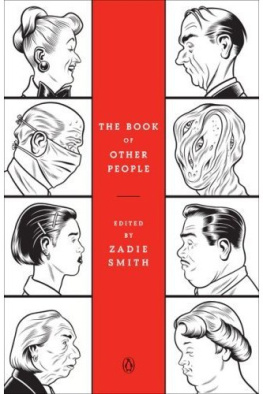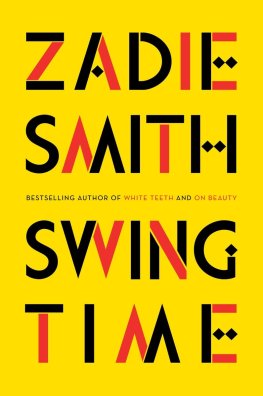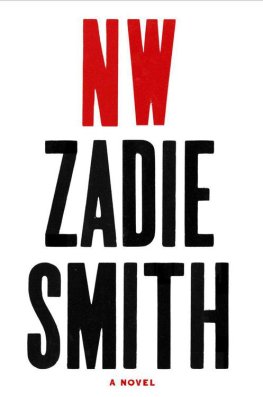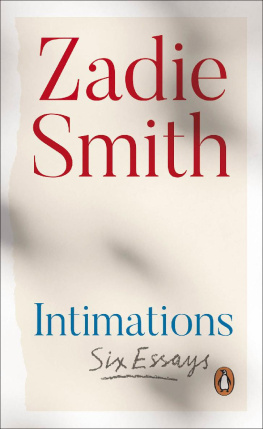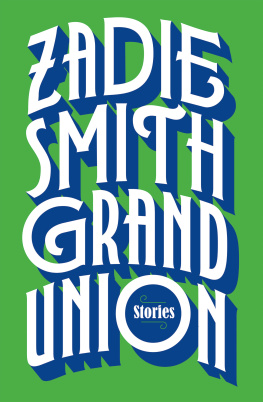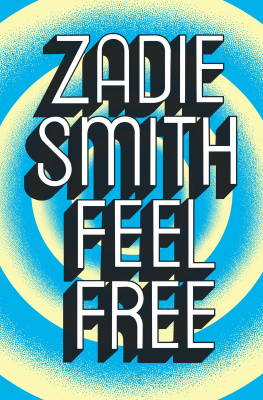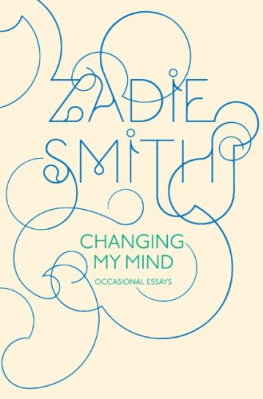Zadie Smith (ed.) - The Book of Other People
Here you can read online Zadie Smith (ed.) - The Book of Other People full text of the book (entire story) in english for free. Download pdf and epub, get meaning, cover and reviews about this ebook. year: 2007, publisher: Penguin Books, genre: Art. Description of the work, (preface) as well as reviews are available. Best literature library LitArk.com created for fans of good reading and offers a wide selection of genres:
Romance novel
Science fiction
Adventure
Detective
Science
History
Home and family
Prose
Art
Politics
Computer
Non-fiction
Religion
Business
Children
Humor
Choose a favorite category and find really read worthwhile books. Enjoy immersion in the world of imagination, feel the emotions of the characters or learn something new for yourself, make an fascinating discovery.
- Book:The Book of Other People
- Author:
- Publisher:Penguin Books
- Genre:
- Year:2007
- Rating:4 / 5
- Favourites:Add to favourites
- Your mark:
- 80
- 1
- 2
- 3
- 4
- 5
The Book of Other People: summary, description and annotation
We offer to read an annotation, description, summary or preface (depends on what the author of the book "The Book of Other People" wrote himself). If you haven't found the necessary information about the book — write in the comments, we will try to find it.
The Book of Other People — read online for free the complete book (whole text) full work
Below is the text of the book, divided by pages. System saving the place of the last page read, allows you to conveniently read the book "The Book of Other People" online for free, without having to search again every time where you left off. Put a bookmark, and you can go to the page where you finished reading at any time.
Font size:
Interval:
Bookmark:
Table of Contents

PENGUIN BOOKS
Published by the Penguin Group
Penguin Group (USA) Inc., 375 Hudson Street, New York, New York 10014, U.S.A.
Penguin Group (Canada), 90 Eglinton Avenue East, Suite 700, Toronto,
Ontario, Canada M4P 2Y3 (a division of Pearson Penguin Canada Inc.)
Penguin Books Ltd, 80 Strand, London WC2R 0RL, England
Penguin Ireland, 25 St Stephens Green, Dublin 2, Ireland (a division of Penguin Books Ltd)
Penguin Group (Australia), 250 Camberwell Road, Camberwell,
Victoria 3124, Australia (a division of Pearson Australia Group Pty Ltd)
Penguin Books India Pvt Ltd, 11 Community Centre, Panchsheel Park, New Delhi - 110 017, India
Penguin Group (NZ), 67 Apollo Drive, Rosedale, North Shore 0632,
New Zealand (a division of Pearson New Zealand Ltd)
Penguin Books (South Africa) (Pty) Ltd, 24 Sturdee Avenue, Rosebank, Johannesburg 2196, South Africa
Penguin Books Ltd, Registered Offices:
80 Strand, London WC2R 0RL, England
First published in Great Britain by Hamish Hamilton, an imprint of Penguin Books Ltd. 2007
First published in the United States of America in Penguin Books 2007
Introduction and Hanwell Snr copyright Zadie Smith, 2007; Selection copyright 826NYC, 2007; Copyright David Mitchell, 2007; Copyright Daniel Clowes, 2007; Copyright A. L. Kennedy, 2007; Copyright ZZ Packer, 2007; Copyright Andrew OHagan, 2007; Copyright Nick Hornby, 2007; Copyright Posy Simmonds; Copyright Edwidge Danticat, 2007; Copyright Aleksandar Hemon, 2007: Copyright Chris Ware, 2007; Copyright Hari Kunzru, 2007; Copyright Toby Litt, 2007; Copyright Adam Thirlwell, 2007; Copyright Heidi Julavits, 2007; Copyright George Saunders, 2007; Copyright Jonathan Safran Foer, 2007; Copyright Vendela Vida, 2007; Copyright Miranda July, 2007; Copyright A. M. Homes, 2007; Copyright Dave Eggers, 2007; Copyright Jonathan Lethem, 2007; Copyright Colm Toibin, 2007; Copyright Andrew Sean Greer, 2007 All rights reserved
Gordon by Andrew OHagan, Hanwell Snr (as Hanwell Senior) by Zadie Smith, Magda Mandela by Hari Kunzru, Puppy by George Saunders, Roy Spivey by Miranda July, and Donal Webster by Colm Toibin first appeared in The New Yorker. Nigora by Adam Thirlwell and J. Johnson by Nick Hornby with illustrations by Posy Simmonds first appeared in The Guardian (London) . Cindy Stubenstock (as Fair Art) by A. M. Homes published in Exhibit-E, New York.
Publishers Note
These selections are works of fiction. Names, characters, places, and incidents either are the product of the authors imagination or are used fictitiously, and any resemblance to actual persons, living or dead, business establishments, events, or locales is entirely coincidental.
LIBRARY OF CONGRESS CATALOGING IN PUBLICATION DATA
The book of other people / edited by Zadie Smith.
p. cm.
eISBN : 978-1-101-20126-8
1. Short stories, American. 2. Short stories, English.
3. Characters and characteristics in literature. 4. FictionTechnique. I. Smith, Zadie.
PS648.S5B66 2007
823.018dc22 2007038785
The scanning, uploading and distribution of this book via the Internet or via any other means without the permission of the publisher is illegal and punishable by law. Please purchase only authorized electronic editions, and do not participate in or encourage electronic piracy of copyrighted materials.
Your support of the authors rights is appreciated.
http://us.penguingroup.com
Introduction
The Book of Other People is about character. The instruction was simple: make somebody up . Each story was to be named after its character: Donal Webster by Colm Tibn, Cindy Stubenstock by A. M. Homes, Frank by A. L. Kennedy, and so on. When the commission was sent out, there were no rules about gender, race or species. This freedom resulted in The Monster by Toby Litt and Puppy by George Saunders. Late in the making of this book I tried to make a case for first and last names, for reasons of uniformity. The idea was not popular. Reproduced here is Edwidge Danticats protest, convincing in its simplicity: I think the variety of names is good. It makes it less monotonous-looking. Since people are named different things by different people. Surnames have not been forced upon Danticats Ll or Adam Thirlwells Nigora or on any others who did not want them. In one case, the omitted last name is the deliberate secret upon which the story hinges. In another - to use a distinction of Simone Weils - the character is a sacred human being and not a person or personality, and his particular name is not important.
There are twenty-three stories in this volume, too many to mention individually. Each is its own thing entirely. The book has no particular thesis or argument to convey about fictional character. Nor is straight realism or naturalism - if such things exist - the aim. The hope was that the finished book might be a lively demonstration of the fact that there are as many ways to create character (or deny the possibility of character) as there are writers. It is striking to see how one simple idea plays out in individual minds, the character of the prose itself being as differentiated as the other people with which these stories are nominally populated. As editor, I have tried to retain the individuality of each piece by leaving them, by and large, little changed.
There is, however, an element of their character that has been removed: the fonts. Publishers standardize fonts to suit the style of the house, but when writers deliver their stories by e-mail, each font tells its own story. There are quite a few writers in this volume who use variations on the nostalgic American Typewriter font (and they are all American), as if the ink were really wet and the press still hot. We have two users of the elegant, melancholic Didot font (both British), and a writer who centres the text in one long, thin strip down the page, like a newspaper column (and uses Georgia, a font that has an academic flavour). Some writers size their text in a gigantic 18. Others are more at home in a tiny 10. There are many strange, precise and seemingly intimate tics that disappear upon publication: paragraphs separated by pictorial symbols, titles designed just so, outsized speech marks, centred dialogue, un-centred paragraphs, no paragraphs at all. It seems a shame to lose these idiosyncratic layouts and their subtle effects. Anyway: I hope what remains will satisfy.
Before leaving you to the stories themselves, Id like to speak briefly of a technical matter, one that is usually considered to be in bad taste if you are speaking of the Art of Fiction: money. This book is a charity anthology, which means the editor must ask writers to work for free, knowing full well that a story is like a gas that expands into whatever available space one has. When you begin a story its impossible to say how much time will pass before youre able to finish it. It might take two hours of your time, or a few days, or four months, or more (this is particularly true for graphic novelists). So it was with this project. I want to thank all the writers for putting time aside - sometimes a great deal of time - to do something for nothing. Traditionally, writers denounce the very idea of writing for no remuneration (I dont want the world to give me anything for my books, George Eliot once said, except money to save me from the temptation of writing only for money), but maybe there is also an occasional advantage in writing once again as you wrote in the very beginning, when it was still simply writing and not also a strange breed of employment. It is liberating to write a piece that has no connection to anything else you write, that neednt be squished into a novel, or styled to fit the taste of a certain magazine, or designed in such a way as to please the kind of people who pay your rent. In The Book of Other People we find writers not only trying on different skins but also unlikely styles and variant attitudes, wandering into landscapes one would not have placed them in previously. I recommend them to you with the proviso that their order is simply alphabetical (by character). Each reader should line them up as they like.
Next pageFont size:
Interval:
Bookmark:
Similar books «The Book of Other People»
Look at similar books to The Book of Other People. We have selected literature similar in name and meaning in the hope of providing readers with more options to find new, interesting, not yet read works.
Discussion, reviews of the book The Book of Other People and just readers' own opinions. Leave your comments, write what you think about the work, its meaning or the main characters. Specify what exactly you liked and what you didn't like, and why you think so.

